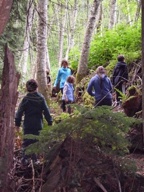Greening the Curriculum
How do we create graduates for the 21st century if we're still teaching a curriculum developed for the 20th century?

Greening the curriculum means ensuring that students are capable of taking on the 21st century challenges of global warming and climate change (the most serious threat ever to face humanity), social inequities, unsustainable lifestyles, and the urgent need to switch to a renewable energy-based economy.
Greening the curriculum means being open to Nature as Teacher, the outdoors as classroom, and sustaining life for all future generations as the most important learning objective in our curriculum.

"Perhaps never before have the needs of human society and the objectives of education been so closely linked, nor has education ever had so compelling a rationale and so urgent a responsibility to contribute to the societal change needed to ensure the survival of the planet and a sustainable future."
– Jean Perras, Learning for a Sustainable Future
Greening the Curriculum — A Green Curriculum Model
Please take advantage of my good fortune. I had the opportunity to become the Coordinator of Environmental and Sustainability Programs at an independent school in Toronto (Canada), and that gave me the (much coveted) time and resources to research and map out a holistic way of greening the curriculum for my school — and now yours.
It's based on the new knowledge, understanding, skills, experiences and attitudes needed to create a generation of graduates . . .
- who have a grounding in compassion and ethics (the impacts of climate change have been hitting less-developed nations first and worst)
- who grasp the science of the greenhouse effect and global warming and the current
and impending impacts of climate change
- who have a clear understanding of how their health and ecosystem health are interrelated
- who know they are part of Nature
- who understand the ecological principles underlying how life works on Earth
- who can approach environmental, social and economic problems with a solutions focus
- and who, because they understand the principles and processes of sustainable development (as defined by the United Nations), can become the change needed in the world.

(Click on the diagram to see a larger version.)
The Green Curriculum Model for greening the curriculum is presented in an integrated, whole school framework. You can check out the entire sequence, or only your grade level, though there's much to learn by checking out the whole thing.
A Developmentally Appropriate
Sustainability Focus for Each Level
There's a different, developmentally appropriate focus for each age/grade level:
- If you teach Preschool/Kindergarten to Grade 3 (1-8 year olds), your vital focus will be on
NATURE BONDING
- If you teach Grades 4 to 5/6 (9-11 year olds), you will want to include
ECOLOGICAL PRINCIPLES
in everything you teach
- If you work with Grades 6/7 to 10 (12-15 year olds), your focus will be
ENVIRONMENTAL SOLUTIONS
- If you teach Grades 11 to 12 (16-18 year olds), you'll want to look for ways to include
SUSTAINABLE DEVELOPMENT
in your subject area(s)

As well, there are three essential integrating themes:
-
ecological ethics
as the foundation of the curriculum model
- climate change /
global warming
and renewable energy as the overarching focus
-
environmental and ecosystem health
as the backdrop to everything we teach
Plus,
integration
itself serves as an ecological teaching tool.
This green curriculum model is for you if you recognize the dire consequences of not educating for sustainability. It was created to be as simple as possible, so that you'll adopt as many of these ideas as possible, weaving them into your teaching and your school culture as quickly as possible.
After all, if we don't intentionally choose to teach for sustainability, then by default we're teaching for UNsustainability.
The next step is up to all of us. It's for you and me and our colleagues to actually integrate Nature and the Earth, ecological principles, environmental solutions and sustainable development, along with ethics, global warming / climate change, renewable energy, and learning about environmental health, into our teaching – across the curriculum — no matter what grade level or subjects we teach.

The future for our students — and all life on Earth — depends on us. On our willingness to open our classroom doors to the natural world. On our courage to seek out Nature as Teacher. On our understanding of the global climate change emergency. And on our compassion for our students and all future generations of children, of all species. We must make life itself more important than
covering the curriculum.

Do You Have a Story to Share
About Greening the Curriculum?
Do you have a great story about greening your curriculum? Have you come up with ways to implement transformative education for sustainability? Have you used one of the ideas from GreenHeart Education's green school curriculum model? We would love to hear what has worked — or hasn't worked — for you, and how your students responded.
Stories of Greening the Curriculum
Shared by Others
Click on the links below to read the stories contributed by other visitors to this page....
Greening School in Post-Crisis Zones
Hello,
I'm happy to tell you about my success in greening schools that are in crisis zones here in the Democratic Republic of the Congo in central Africa. …
Kids Can Save The Planet
Dylan is a young filmmaker who took on a journey to learn all about plastic pollution and how it affects the planet. The success of his first film led …
Growing Up WILD
We developed this for early childhood educators and believe you could use it in your workshops. Please see Growing Up WILD at https://www.fishwildlife.org/projectwild/gro …
Click here to write your own.





